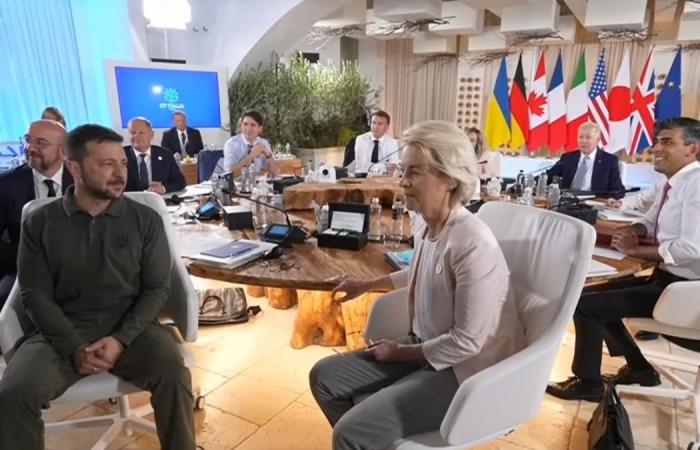The G7 he Italian presidency has given the green light to $50 billion loan to Ukraine, but the terms of the agreement, who will bear the burden of the financing, and for what purpose they will be allocated are not known in detail. The announcement came from the Elysée on the evening of Wednesday 12 June, on the eve of the G7 meeting in Bari: “The G7 leaders have reached an agreement for the allocation of 50 billion dollars in favor of Ukraine, through use of frozen Russian assets. This financing will take place by 2024.” And the Elysée continues: “It was an American initiative initially, this loan will be repaid from the proceeds of frozen Russian assets, but if for one reason or another the Russian assets were not to be released, or no longer produced the income necessary to finance this loan (coupons, dividends, etc), then the question of burden sharing arises”. An essentially American loan ends the Elysée, “but which can be integrated with European money or national contributions”.
Meanwhile, the EU has already approved economic support for Kiev of 50 billion euros in February, along the lines of the Next Generation EU, with 33 billion in loans and 17 in non-repayable financing. On the US side, however, the last support arrived last April, with Congress allocating a 61 billion dollar package. But of these, only 7.85 billion will go directly to Kiev, the rest, according to a report by Kiel Institute for the World Economywill be used for the replenishment of the stocks of weapons and ammunition of the US armed forces donated to Ukraine, for the direct purchase of US armaments by Kiev, and for the management and coordination of federal agencies and US command operations in Europe.
But where would the Russian assets needed to finance the G7 loan be found? According to the FT they would amount to 260 billion euros, and would be deposited largely (191 billion) in Europe at Euroclear, the largest European clearing company, depository of securities, which regulates many international transactions of shares, bonds, derivatives, investment funds and ETFs. These would mainly be Eurozone government debt securities denominated in euros belonging to the Russian Central Bank. Another 20 billion would be deposited in Luxembourg and the remaining 50 billion between Switzerland, the United Kingdom, Canada, Australia and the United States, the latter would hold between 5 and 8 billion.
The CEO of Euroclear, Livie Mostrey, expressed her opinion last February on the fact that the assets of the Russian Central Bank are mainly denominated in euros and are present in Europe. In an interview with the FT you expressed strong concerns about the US desire to use these assets to guarantee the aforementioned loan, through the issuance of bonds. “Using the seized funds would be the equivalent of a confiscation, albeit indirect, and would have the same destabilizing effect on the markets as a direct confiscation.” And Mostrey concluded: “I am confident that prudence and reason will prevail, because confiscation would have a significant impact on trust in the Euroclear system, in the European capital market and in the euro”.
For this reason in the end, the G7 compromise focused on the use of interest, rather than on the direct guarantee of Russian assets. On this point, Euroclear would have appeared more confident. In 2023 it would have already obtained 4.4 billion euros in interest and the forecast would be to obtain between 3 and 4 on average every year, to repay the loan securitized by the United States. However, the use of these funds exposed Euroclear to countless legal proceedings initiated in Russia, and not only that, also for assets of Russian private companies deposited in the same Belgian company. This was the case of a group of Italian holders of thirty-year Gazprom bonds, who, following an error on the part of Euroclear (Gazprom is not subject to sanctions), asked Brussels to release the funds for the payment of the coupons.
And doubts about the effectiveness of using proceeds from Russian assets also involve technicians. Yury Gorodnichenkoprofessor of Ukrainian economics at the University of Berkeley (California), quoted by German state TV Deutsche Welle, expresses his doubts. According to Gorodnichenko, Since the beginning of the war, Ukraine has obtained financing for 297 billion of Euro. But the war effort combined with the serious economic situation of the country, with a deficit of 20-30% of GDP, Greece at the height of its debt crisis reached 13.5%, would require aid of 100-150 billion dollars the year. This loan is welcome, concludes Gorodnichenko, but it is necessary that these assets remain frozen for 10-20 years, so that their returns can cover the loan. But in the meantime the war could end and Russian assets may no longer be available, precisely at the crucial moment of reconstruction.
Finally, there are the unknowns linked to the possibility that some Russian assets will be thawed and no longer available, if some European countries (such as Hungary) decide in the future to veto the six-monthly renewal of sanctions against the Kremlin. Until a few days ago, according to an article that appeared on Politicit seemed that even the agreement on the use of interest would not go through, due to the opposition of France and Germany: “We might be stupid, but not so stupid as to accept a compromise where the United States takes the loan, and the ‘Europe takes all the risks’, a senior EU official confided. Washington could not guarantee the fund with its own taxpayers’ money, without having to involve Congress to ratify the agreement. For this reason he would have proposed the use of the proceeds of Russian assets in Europe and the sharing of the burdens in the event of bankruptcy among the countries that hold them.
Friedrich Magnani, 16 June 2024
Nicolaporro.it is also on Whatsapp. Simply click here to subscribe to the channel and always be updated (free)
Did you like this article? Read also
Follow us on our channels





